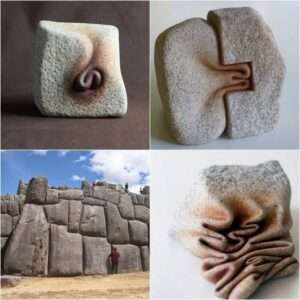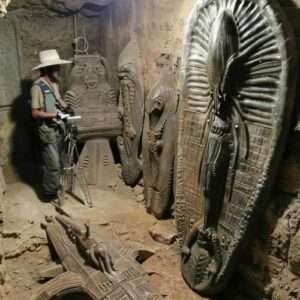The Zodiac of Dendera stands as an enduring symbol of ancient Egyptian astronomical knowledge and artistic brilliance. Carved into the ceiling of the pronaos, or entrance hall, of a chapel dedicated to Osiris within the majestic Temple of Hathor, this intricate bas-relief offers a captivating glimpse into the celestial beliefs and practices of ancient Egypt.

Crafted during the Ptolemaic period, around the first century BCE, the Zodiac of Dendera is a circular depiction adorned with a mesmerizing array of astronomical symbols and figures. At its center lies a representation of Nut, the goddess of the sky, arching across the heavens. Surrounding her are twelve figures, each associated with one of the traditional zodiac signs, such as Aries, Taurus, and Gemini. These symbols serve as a celestial calendar, reflecting the annual journey of the sun through the zodiacal constellations.

Beyond its representation of the zodiac, the Dendera bas-relief is adorned with a multitude of celestial motifs and mythological figures, including gods, goddesses, and various astronomical phenomena. Depictions of the Nile god Hapy pouring water, the goddess Isis, and the bull god Apis further enrich the scene, blending religious symbolism with astronomical observation.

Scholars have long debated the significance and purpose of the Zodiac of Dendera. Some interpret it as a purely symbolic representation of the cosmos, serving as a tool for religious rituals and ceremonies. Others suggest that it may have held practical astronomical importance, aiding in the calculation of time, seasons, and celestial events crucial for agricultural and religious calendars.

Despite centuries of study, the Zodiac of Dendera continues to inspire fascination and intrigue, offering valuable insights into the sophisticated understanding of astronomy and cosmology in ancient Egypt. Its preservation within the Temple of Hathor, a site dedicated to the goddess of love, joy, and motherhood, underscores the deep connection between the heavens above and the spiritual beliefs of the ancient Egyptians. As visitors gaze upon its celestial wonders, they are transported back in time, immersed in the mystical world of pharaonic Egypt and the enduring legacy of its astronomical achievements.






